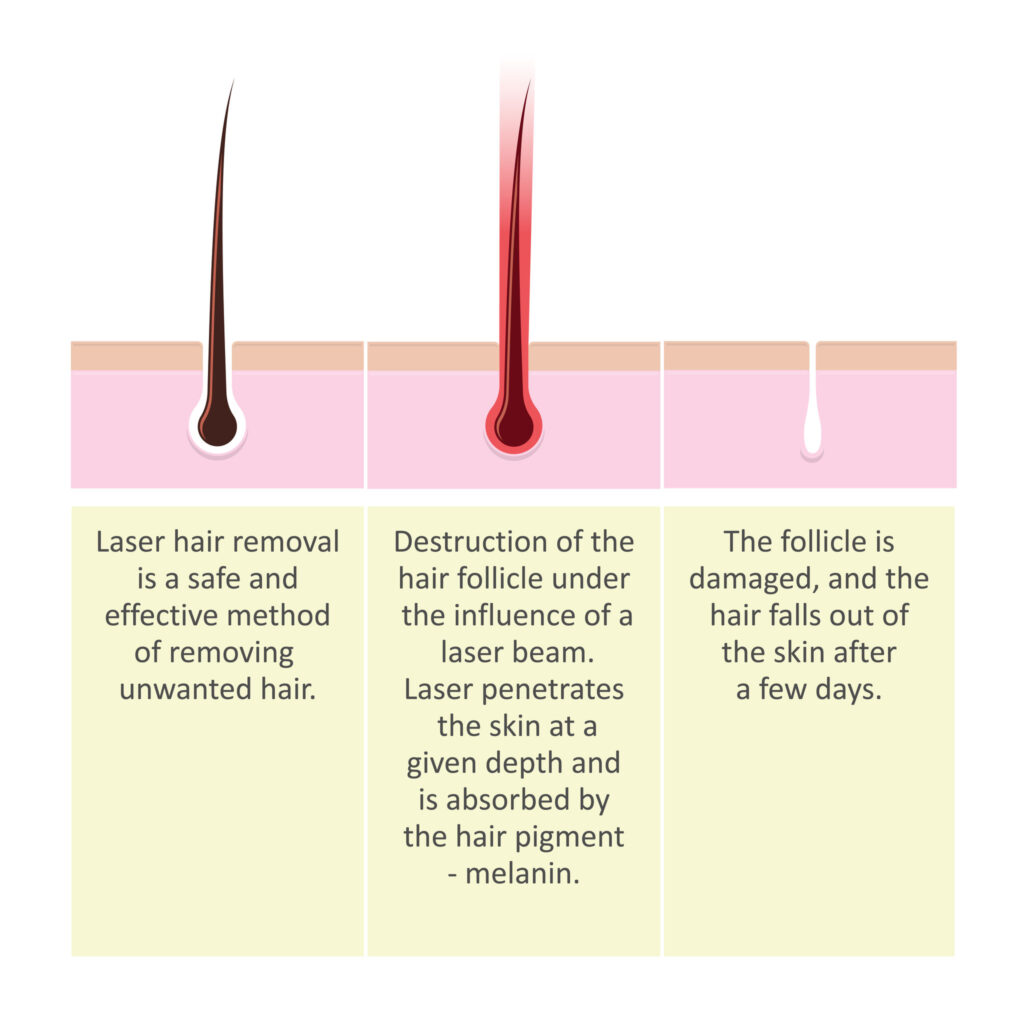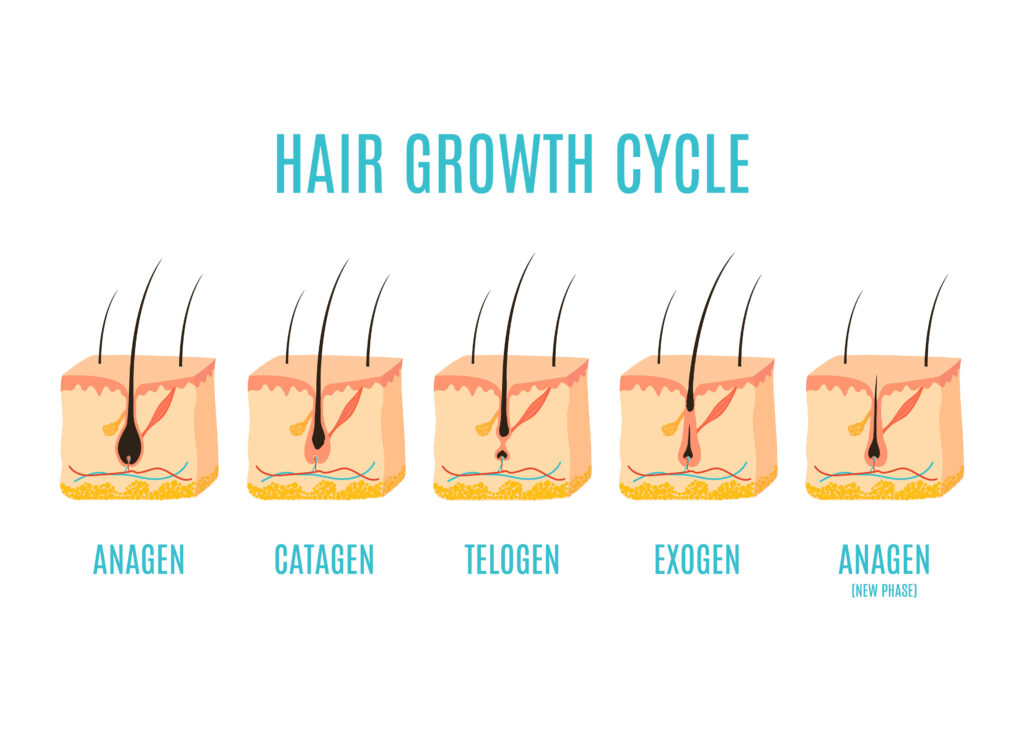Does hair grow back after laser hair removal? It’s a question many clients ask before they’ve had their first laser hair removal procedure done.
Why does hair grow back after laser hair removal is a question you might ask after you’ve had your first treatment and actually see that hair does grow back again.
Hopefully, you didn’t go into the first laser treatment believing that laser hair removal guarantees permanent hair removal because it does not. It can, with repeated treatments, offer permanent hair reduction where the total amount of unwanted hair you have is reduced, possibly significantly.
Does Hair Grow Back After Laser Hair Removal?
When you have laser hair removal treatment, you’ll typically find that several days after the treatment, the hair will begin to fall out. With both laser and IPL treatment, I experienced hairs still falling out even a week after treatment.

Hair does tend to grow back after laser hair removal but we need to distinguish between what hair is actually growing:
Is it the same hair that was treated, that is starting to grow back again?
Is it previously dormant hair, that was not visible when you had the laser treatment, but has now started growing and is visible above the skin?
Hair grows in cycles, which is why you can’t achieve full hair removal in one or two sessions. Not all hair is in the growth phase at any given time and thus it can’t be treated at that time.
Let’s look at the hair growth cycle and how it relates to your laser hair removal treatment schedule because the two (should) work hand in hand.
Laser Hair Removal And Hair Growth
Hair grows in a cycle comprising four phases. It’s important to note that laser hair removal only removes hair successfully in the anagen or growth phase.

Hair removal treatments should be scheduled to hit the most hairs in the anagen phase as possible. Since hairs on your body may be in any phase at any given time, when you see new hairs popping out of the skin, they’re in the growth phase.
When you’ve had a laser hair removal treatment and several weeks later start to see new hairs coming out from the skin, they are in the growth phase and it means you’re probably getting close to needing another laser hair removal session to zap them.
So when you see hair growing several weeks after laser hair removal, it might be hair that was treated the last time you had the treatment. Or, it might be new hair, hair that was dormant during the last last hair removal treatment that is now in the anagen phase.
This is why multiple laser – or Intense Pulsed Light or Electrolysis – hair removal treatments are usually required for permanent hair reduction: Hair grows in phases and you simply can’t zap all unwanted hair in one treatment. Or two, or three, or four…It takes time.
To learn more about each phase of the hair growth cycle, check out my Hair Growth Cycle page on my related website, Bald Guy Beard. It has some great (I hope!) info if you shave your head and have a goatee, or are thinking about it.
page on my related website, Bald Guy Beard. It has some great (I hope!) info if you shave your head and have a goatee, or are thinking about it.
Does Hair Grow Back Thicker After Laser Hair Removal?
One myth concerning hair growth is that hair grows back thicker, thinner, lighter or darker with hair removal treatments.
With temporary hair removal treatments like shaving, waxing, depilation or plucking, hair will always grow back the exact same way it was before treatment. Always. Hair growth is determined by genetics, not your choice of hair removal.
However…
With electrolysis, laser or IPL treatments, hair can grow back thinner and finer with repeated treatments.
This is because each of these procedures targets the hair down to the bottom of the hair follicle and damages its ability to regrow hair in the future. Electrolysis is the only permanent hair removal option approved by the FDA and while it may require several treatments to do so, kills the follicle’s ability to regrow hair.
Laser and IPL on the other hand don’t guarantee permanent removal but can with repeated treatments over time offer permanent hair reduction. The total amount of unwanted hair you have decreases over time.
And in all three cases, treated hairs that do regrow may grow back thinner and less noticeable. Eventually, many hairs may cease to grow back at all.
Bumps After Laser Hair Removal
Often after laser hair removal as the treated hairs are falling out, you’ll tend to notice small bumps or ingrown hairs on your skin. You may also notice reddening skin almost a bit like razor burn. Both tend to go away within a few days. The reddened bumps tend to occur because of the laser light flash but generally disappears soon after treatment, in my experience.
After both laser and IPL treatment, I noticed small razor bump-type zits that went away pretty quickly, too. Once the skin had healed and was no longer sensitive, I found that I could lightly exfoliate while showering with a loofah and the bumps and ingrown hairs disappeared.
You may want to wait 4-5 days to exfoliate, or until it has healed, if your skin is particularly irritated. Bumps after laser hair removal is relatively normal and tends to go away quickly following treatment.
Your laser practitioner may offer or suggest a post treatment soothing cream or lotion to apply to assist in the skin healing.
Shaving After Laser Hair Removal
Laser removal practitioners often suggest refraining from any home hair removal practices in between treatments. After all, you’re paying for the laser treatment to remove the hair so why shave, wax, or use another method that could interfere with the success or the laser hair removal treatments?
Personally, I never shaved the area I was having treated with either laser or IPL hair removal at all. l found after treatment, I was happy just to let the hairs do their thing and fall out as they’re supposed to.
Having said that, if you do want to shave the area for whatever reason, I’d wait until the skin has healed and personally, I’d wait until the hair has completely fallen out to do so. That way you get a better sense as to how the hair removal treatment is coming along and can actually see the progress.
Itching After Laser Hair Removal
Research from Spain has shown that laser hair removal can cause an itchy skin rash of sorts following treatment. It typically occurs with people who already suffer from allergies such as hayfever or asthma.
The research showed that the reaction was relatively uncommon however:
The researchers searched a database that contained details of all people who underwent laser hair removal at Spanish beauty clinics over a 4-year period. Of a total of 13,284 people, 36 developed hives within 6-24 hours of the procedure.
The rashes always affected areas of skin treated with the laser, which included the legs, groin, armpit, forearms, and upper lip. Rashes were typically red or purple in colour, often developed in a circular pattern, and had multiple raised itchy spots or patches.
medwireNews
The research also reported that people that got the reaction were typically given corticosteroid tablets and that in all cases, the rash healed within 7-30 days.
Conclusion
- Hair grows in a cycle encompassing four phases as described above. Learning about the hair growth cycle will help you achieve better laser hair removal results.
- Hair does grow back after laser hair removal but it could be either new, previously dormant hair that is now in the growth phase or hair that was successfully treated with laser and has also entered the growth phase again.
- Over time and with repeated treatments, you can achieve permanent hair reduction with laser hair removal.
- A small number of people may experience skin irritation including reddened skin and a rash after laser hair removal treatment. Research shows that it tends to pass within 7-30 days but medication was required for a small number of people.
Recent Posts
Laser hair removal may not be as effective for individuals with red hair, as well as those with blonde, gray, or white hair, because the laser targets the pigment (melanin) in the hair follicle....
Laser remains a very popular form of hair removal and for several reasons. While not a permanent hair removal option like electrolysis, the benefit of laser is that it enables you to treat more...


